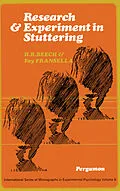Research and Experiment in Stuttering presents the phenomena and characteristics of stuttering. This book describes the types of stuttering that may appear in many different psychological and physical settings.
Organized into seven chapters, this book starts with a discussion of the definition of stuttering, which usually refers to particular forms of interruption to the free flow of speech with sufficient frequency to considerably impede verbal communication. This text then discusses several matters, including sex ratios of stutterers, incidence of stuttering, and prognosis of the disorder. Other chapters explain how the idea of psychological causation for stuttering developed. This book discusses as well the common observation that the stutterer appears to have a usually higher level of anxiety that the nonstutterer. The final chapter deals with the three significant procedures that have been used as methods for the modification of stuttering.
This book is a valuable resource for psychologists and psychiatrists.
Inhalt
List of Illustrations
Acknowledgment
Chapter 1. The Background to Stuttering
1. Introduction
2. The Manifestations of Stuttering
3. The Incidence and Prevalence of Stuttering
4. The Prognosis for Stutterers
5. The Relation between Age and Stuttering
6. The Relation between I.Q. and Stuttering
7. The Relationship of Stuttering to Sex
8. The Relation between Socio-economic Factors and Stuttering
9. Conclusions
Chapter 2. Definition, Diagnosis and Measurement of Stuttering
A. Definition
B. Diagnosis
Differential Diagnosis
Diagnosis by the Listener
C. Methods of Measurement
(a) Severity Rating Scales
(b) Analysis of Disfluencies
D. Rate of Reading and Speaking
Conclusions
Chapter 3. Theories of Stuttering
1. Introduction
2. Stuttering as a Perceptual Defect: Cherry and Sayers
3. Organic Theory of Stuttering: West
4. Perseverative Theory of Stuttering: Eisenson
5. An Expectancy Theory of Stuttering: Wischner
6. The Diagnosogenic Theory of Stuttering: Johnson
7. A Conflict Theory of Stuttering: Sheehan
8. Conclusions
ChapterH 4. The Genetic and Organic Factors in Stuttering
1. Laterality
2. The Genetics of Stuttering
3. The Cardiovascular System
4. Metabolism and Physiology
5. Drugs
6. The Nervous System
7. The Respiratory System
8. The Muscle System
9. Conclusions
Chapter 5. The Personality of Stutterers
1. Introduction
2. Stuttering as a Neurotic Manifestation
3. General Personality Characteristics of the Stutterer
4. Investigations of Specific Personality Variables
5. The Self Concept
6. Anxiety and Hostility
7. Stutterer Subgroups
8. Test Scores as Prognostic Indicators
9. Conclusions
Chapter 6. Experimental Investigations of Three Basic Phenomena of Stuttering
A. The Consistency and Expectancy Effects
1. Description
2. Scoring
3. Expectancy and Adaptation
4. Word Analysis
5. Meaningfulness
6. Conclusions
B. The Adaptation Effect
1. Description
2. Methods of Eliciting Oral Performance
3. Independent Variables Studied
4. Scoring
5. Reliability
6. Expectancy and Adaptation
7. The Transfer of Adaptation
8. Adaptation in the Listener and the Nonstutterer
9. Adaption, Prognosis and Therapy
10.Theories of Adaptation
11.Conclusions
Chapter 7. Studies of Delayed Authority Feedback, the "Rhythm Effect" and Operant Conditioning, in the Modification of Stuttering
1. Introduction
2. Experimental Studies of D.A.F.and Masking
3. Experimental Studies of the "Rhythm Effect"
4. Operant Conditioning and Stuttering
5. Conclusions
References
Author Index
Subject Index
9. Adaptation, Prognosis and Therapy
10. Theories of Adaptation
11. Conclusions
C. Spontaneous Recovery
1. Description
2. Experimental Evidence
